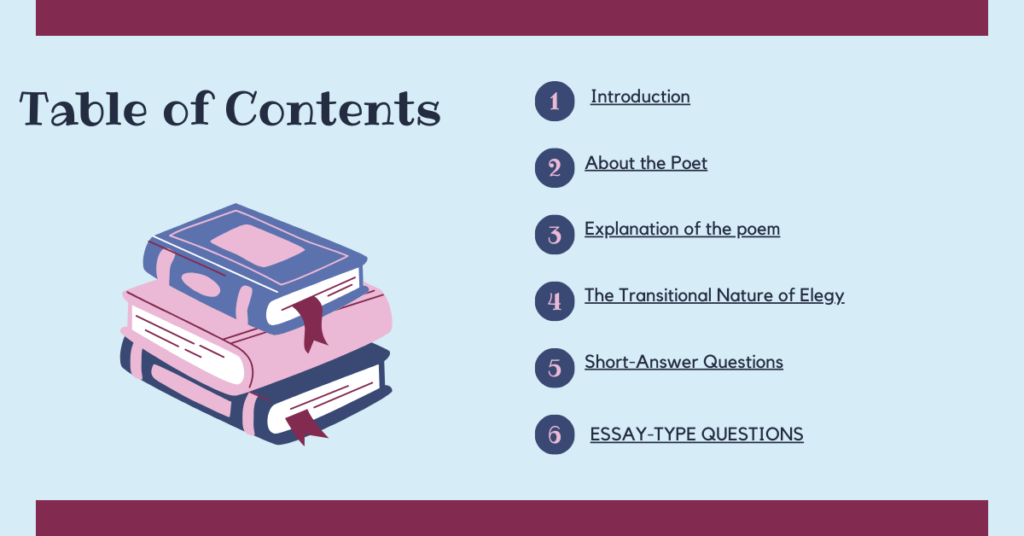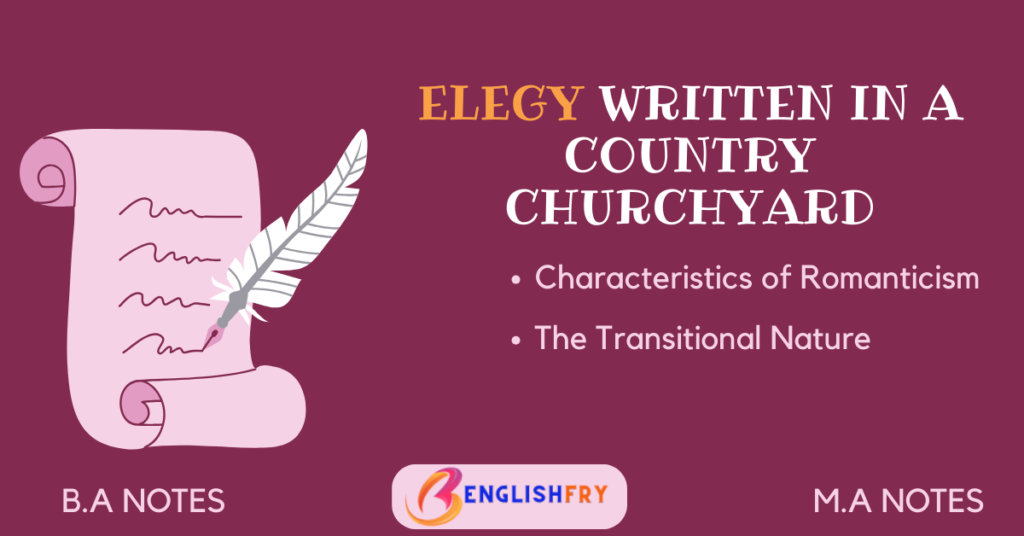Table of Contents
ToggleIntroduction
“Elegy Written in a Country Churchyard” is a poem composed by Thomas Gray, first published in 1751. Although the origin of the poem is unknown, it was partly inspired by Gray’s thoughts following the death of the poet Richard West in 1742. The poem is more of an elegy in name but not in form. It employs a style similar to that of contemporary odes, but it encapsulates a contemplation on death, and remembrance after death. The narrator uses the occasion to reflect on the lives and death of the obscure rustics buried in the churchyard. When Gray designated his work as an elegy, he placed it in a long tradition of meditative poems that focus on human mortality and sometimes reflect specifically on the death of a single person. By setting his meditation in a typical English churchyard with mounds, gravestones, and yew trees, Gray was also following a tradition. The poem is unique in the sense that it does not just lament death but also reflects on the toil , struggle and anonymity of the rustic dweller.
About the Poet
Thomas Gray was born in Cornhill, London in 1716. His father, Philip Gray, was a clerk and his mother, Dorothy Antrobus, earned by making hats for women.. He was the fifth of 12 children, and the only child of Philip and Dorothy Gray to survive infancy. Gray’s mother was keen to send him to Eton College where two of his uncles worked. He recalled his schooldays as a time of great happiness, as is recorded in his “Ode on a Distant Prospect of Eton College”. In 1734 Gray went up to Peterhouse, Cambridge but could not indulge in studies as he disliked the curriculum. His family wanted him to study law but he spent most of his undergraduate years reading classical and modern literature.
It was in 1742, mainly after his close friend Richard West died, that Gray began writing poems seriously. He moved to Cambridge and started training himself for literary study. For most of his life Gray was a scholar in Cambridge, and only later in his life did he begin traveling again. He was so self- critical and fearful of failure that he published only thirteen poems during his lifetime. Gray died in July 1771 at Cambridge, England.
Gray began writing his masterpiece, the Elegy Written in a Country Churchyard, in the graveyard of St Giles parish church in Stoke Poges, Buckinghamshire, in 1742. After several years of leaving it unfinished, he completed it in 1750. Its reflective, calm and stoic tone was greatly appreciated. It has been translated into many languages including classical languages such as Latin and Greek. It is still one of the most popular and most frequently quoted poems in the English language. Gray did not produce a great deal of poetry.
The “Elegy Written in a Country Churchyard,” however, has earned him a permanent place in the annals of literary history. The poem was written at the end of the Augustan Age and at the beginning of the Romantic period. So it has features associated with both literary periods. Whereas on the one hand, it has the ordered, balanced phrasing and rational sentiments of the Neoclassical poetry, on the other, it tends toward the melancholy, emotionalism and individualism of the Romantic expression. Added to this, it idealizes the common man.

Explanation of the poem
Gray sets the scene for his private and quiet thoughts. He is far from the din of the city and looking out from a country churchyard at a rural scene. It is evening time and the flocks of animals and birds are home bound. Only the nocturnal creatures such as the owl, the cricket etc seem to be around. Although the scene is beautiful, life is not joyous, and Gray reflects that this day dies just like the one before it, as the plowman walks home wearily. The poet is alone, but he is not lonely or tired. The text gives a sense that he enjoys his solitude and stillness around. With these descriptions, Gray creates the backdrop for his melancholy reflections about eternal truths.
Gray uses the churchyard scene to invoke important images: the sturdiness of the elms, death as symbolized by the graves, and the comfort provided by the yews trees shading bodies that sleep entombed. The poet reflects that death for the humble and obscure folks means a cessation of life’s simple pleasures: waking up to the songs of birds, sharing life with a wife and children, and enjoying the fruits of their labour. Gray ponders upon not only the untimely death of young people but on the death that comes after a normal life span. But that does not imply that these unknown people had nothing worthy. In fact the poet appeals to the resourceful ones not to look down upon the simple lives lead quietly in some far off village.
The lines in this stanza provide the central message of the poem: The poor are born with the same natural abilities as members of the upper classes. Who can say what humble people might have accomplished in the great world had they not been constrained by their circumstances and their innate powers not been frozen by chilling poverty. Gray implies that the innocence and beauty of these souls, wasted in their isolated rural environment, and resembling hidden deserts and ocean caves, could have flourished in better conditions. If one boasts of high position, power, beauty or wealth, it is of no value as death overpowers all human attributes. The rich may boast of elaborate memorial services and lavish tombs but these poor folks have no such memorable ceremonies performed as their remembrance.
The poem reminds stoically that nothing can bring back the departed soul and no resounding glorification of the dead will revive them. The dead village folks could have possessed qualities of states men, scholars a and poets, had the conditions of their lives permitted them. But poverty restrained their talent which lay hidden like a flower or a gem not appreciated by others. However some humble mounds have been made to show respect to the dead. These simple memorials ask the passer by to heave a sigh. The poet draws solace from the fact that their poverty restrained them from doing wrong deeds .
Gray returns to the churchyard in this section, remarking on the graves’ simple markers with their badly spelled inscriptions, names, and dates. Some bear unpolished verses or consoling biblical texts; some are decorated with “shapeless sculpture.” Gray is touched that such grave markers show the humanity these dead people share with all men and women (including, by implication, the famous who took paths of glory). Those who remain can sense that the dead “cast one long lingering look” back on what they were leaving and were comforted by at least one loved one. Gray reflects that the voice of general human nature can be heard crying from these graves. The inscriptions on the graves might be simple but they instruct moral lessons to the onlooker.
Gray mentions an eternal and common desire shared by all humans. The dying man longs for remembrance. He desires that someone would shed tears and narrate his tale to the others. Even the ashes of a dead person ask for respect and acknowledgement. Although the inscriptions on the tombs have no rhythm and music, there is hope that some traveler will come that way and read those lines and remember the dead.
The farmer recounts that one morning the poet was nowhere to be seen. He was not at the hill or the heath or near the tree, the stream or the lawn and the wood. Then the farmer saw the poet’s
funeral procession to a church, marked by sad faces and mournful songs. He was buried in the same church yard with simple lines inscribed on the grave beneath an old thorny tree. In this way the poet gives the message that he counts himself amongst common humanity and even died as one of them.
Gray speaks of his grave being “upon the lap of Earth” and not inside the ornate church. He accords himself modest praise and justifies his life as worthwhile. He concedes that despite his “humble birth,” he took pains to educate himself. Although some may consider the poet’s natural melancholy a disadvantage, he himself thought it the source of his poetic sensibility . Gray describes himself as generous and sincere, for which his reward was not worldly fame or fortune (the “paths of glory”) but heavenly “recompense,” in the form of kindred souls. The epitaph concludes by advising the reader not to ask more about the poet’s virtues and frailties but to leave him to God’s care.

The Transitional Nature of Elegy Written in a Country Churchyard
First published in 1751, Thomas Gray’s popular poem “Elegy Written in a Country Churchyard,” was written at a time of great restructuring within the literary world. Caught between the ideas of the neoclassical age surrounding formal and rational thought and the emotion and free-flowing verse characterized by the Romantic period, Gray is often regarded as a transitional artist because his pieces include influences from both literary movements. In analyzing form, literary devices, subject matter, and themes within “Elegy Written in a Country Courtyard, readers find identifiers woven throughout the text which mark the transition from the neoclassicism of the 18th century to the early Romantics.
The structured format of Thomas Gray’s poem is one of the main links between his poetry and neoclassical thought. Gray’s poem follows the popular 18th century notion of strict adherence to literary rules regarding formatting. Gray utilizes iambic pentameter within his piece which makes use of precise phrasing to stress certain syllables and lines in a calculated manner.
For example, one of his stanzas says, “Full many a gem of purest ray serene, The dark unfathom’d caves of ocean bear: Full many a flow’r is born to blush unseen, And waste its sweetness on the desert air” (14). Every other line in his stanzas are compatible, allowing the rhythm of the poem to feel steady. In this example, “serene” matches with “unseen” and “ocean bear” and desert air” work together to fulfill Gray’s pattern. In a repetition of corresponding syllables and lines, each of the poem’s 32 stanzas contains a similar style in a perfectly balanced 128 lines, adhering to the neoclassical tradition of iambic pentameter.
Additionally, Gray utilizes personification throughout his work, which was a common trait among neoclassical poems. Because ancient classical poets and authors spoke of grand notions such as love or pride as though they were living entities, many neoclassical artists adopted this practice. In the eighteenth stanza, he says, “The struggling pangs of conscious truth to hide, To quench the blushes of ingenuous shame, or heap the shrine of Luxury and Pride…” In capitalizing inhuman notions such as Luxury and Pride and speaking about them as though they were living, Gray personifies his ideas as a typical neoclassical artist.
Finally, Gray expresses neoclassical ideas in his presentation of a moral rule within the text. Neoclassical writers enjoyed commenting on ideas of morality within their work, and Gray subscribed to neoclassical ideals by presenting his ideas on right and wrong within his lines. He says, “The boast of heraldry, the pomp of pow’r, And all that beauty, all that wealth e’er gave, Awaits alike th’ inevitable hour. The paths of glory lead but to the grave” (stanza 9).
Here, Gray argues that power, wealth, and beauty do not have any effect on the outcome men’s lives. No matter how powerful, attractive, or rich a person is, Gray reminds his readers that every person must die no matter their circumstances on Earth. In thinking about the morality of man and speaking about the inevitability of death, Gray presents the idea that no man could live forever and that wealthier people should not look down on less educated or rural people, as they all end up in the ground eventually. Because Gray writes out a lesson regarding morality within his text, his piece adheres to a traditional neoclassical writing style in this way.
While Gray utilizes many neoclassical techniques, his work marked a transition between two great literary movements because his language and subject matter often mirrored Romantic era ideals as well. One of the most marked indicators of Gray’s status as a transition to the Romantic style is his celebration of the common people.
While more formal neoclassicist poetry of the 18th century tended to honor heroes, aristocrats or citizens with vast fortunes or fame, Romantic poets often wrote about everyday subjects and themes. Gray comments on the lives of rural workers when he says, “Oft did the harvest to their sickle yield, Their furrow oft the stubborn glebe has broke; How jocund did they drive their team afield! How bow’s the woods beneath their sturdy stroke!” (7).
Gray does not comment on the elements of life known to wealthy aristocrats, but of the labor required in a difficult life on a farm. Gray says, “For them no more the blazing hearth shall burn, Or busy housewife ply her evening care: No children run to lisp their sire’s return, Or climb his knees the envied kiss to share…”(6). Again, Gray speaks of some of the trivialities of everyday life for common people as opposed to scenarios encountered by the wealthy or powerful. He discusses simple acts of rural family life and thus demonstrates his position as a transitional poet between the neoclassical and Romantic Eras.
The elements of nature discussed throughout “Elegy Written in a Country Churchyard” coupled with the rural setting place the piece in the Romantic era. As Romantic era poets often discussed the relationship between man and nature and Gray’s piece expresses a bond between the natural world and human beings, the poem falls into a Romantic category.

Short-Answer Questions
1.What was Gray’s opinion of high-born persons vis-a-vis the low-born?
Ans: Gray admired the virtues of the ordinary people and felt that their potential was not fully explored.
The high-born asserted their power and position by constructing huge memorials for themselves.
2.Explain : The paths of glory lead but to the grave.
Ans: When man enjoys power, he thinks he is invincible. But despite all the glorious deeds, the final resting place is still the grave.
3.What message does the “Elegy” give?
Ans: The “Elegy” asks us to honor the lives of common, unknown people and not just the rich and famous folks. This idea of glorifying mundane, everyday things becomes central to the poem.
4.What is the significance of the Epitaph in the “Elegy”?
Ans: It is an inscription on the grave. The poet imagines how the world would talk about him after reading these lines carved on his grave.
5.How is nature described in the “Elegy”?
Ans: Nature is serene and quiet and adds to the sad tone of the “Elegy”. There are few voices of nature as it is evening time and the day is coming to a close.

ESSAY-TYPE QUESTIONS
1. Write about the structure of the “Elegy”.
Ans: The “Elegy” has been written in quatrains. It may be divided into four sections. The first four stanzas establish the solemn meditative tone and place. The speaker is in a village graveyard at twilight. Stanzas five and six describe the events and activities in which the dead people buried there are no longer able to participate. Stanzas seven to twenty three castigate the great and instruct them not to view the poor with contempt. It is suggested that the poor, too, might have been accomplished and powerful. In fact all men are equal in death. In stanzas twenty four to twenty nine, the poet addresses himself, imagining to be observed by an inhabitant of the village, and finally describing his own death and burial. The poem closes with the speaker’s epitaph, assuring that the resourceful are recompensed through their immortalizing virtues . Thus
“Elegy Written in a Country Churchyard” proceeds from a meditation in the churchyard to a wider consideration of human nature and predicament of the underprivileged lot.in Gray concludes by imagining his own death and how he will be remembered by those who read his epitaph. The Elegy has been skillfully structured with a well- developed progression of thought.
2. What is the significance of the epitaph in the poem “Elegy Written in a Country Churchyard?”
The speaker in “Elegy Written in a Country Churchyard” is contemplating death. He looks upon the graves in the churchyard and he ruminates on those buried there. The poem is also the speaker’s quest to find himself or a quest to understand what is important in life. And this is where the epitaph comes in. Given the implied modesty in the epitaph, we might assume that it was written by someone else; not the speaker himself. This means that another person is looking at the speaker’s death in philosophical contemplation of mortality just as the speaker himself did throughout the context of the poem.
3. How does “Elegy Written in a Country Churchyard” imbibe the twin features of Romanticism and Neo Classicism?
Answer: Although Thomas Gray’s “Elegy Written in a Country Churchyard” is not considered to be part of the Romantic canon, its first twenty lines do advance some classic Romantic themes. Most notably, the first twenty lines of Gray’s poem describe the kind of isolated world of natural beauty favored by most Romantics. In the first stanza, we can see that Gray sets his poem within a world of serene, pastoral beauty. With a wandering herd, an open grassland and a plowman, Gray skillfully develops a world of natural beauty and hard-working farmers. Moreover, since the world is left to the speaker of the poem, it’s suggested that he is alone in this picturesque natural setting. A beautiful and isolated natural setting is a typical feature of Romantic literature, as it nurtures an ideal setting for the Romantic imagination to become manifest. At th same time, it needs to be remembered that Neo-classicism was the dominant influence in the eighteenth century English poetry. Poetry was largely based on literary models provided by Greece and Rome. In the neo-classical tradition , the tone and the rhyme scheme of a poem are measured and even, and the argument is intellectual rather than prone to emotional outpouring .While Gray does not address his elegy to a single individual, which is the standard Classical form, this poem is a moving address to those who are dead and gone but yearned to live ant to be remembered after death. The poem communicates sadness, but the poet is distant from his subjects. Although it is sad that people die unmourned, but that’s the way life is in the larger scheme of nature. So the Romantic traces are present all through but the voice of sane reason is insistently present. Even when Gray seems to be exalting nature in her somber form, there is an underlying restraint that curbs the free flow of the Romantic verve. However the Elegy assimilates the divergent strands effectively.
4.What are the chief themes of the “Elegy”?
Ans: The “Elegy” deals with various themes which have been beautifully portrayed.
- Death is a great equalizer .Even the proud and the mighty must one day lie in the grave, like the humble men and women now buried in the churchyard. No grand memorials and no soothing words about the dead can bring him or her back from death.
- Missed Opportunities : Due to poverty or other handicaps, many talented people never bet the opportunities they deserve. Their worth remains unexplored. However they should not be under Had their potential been tapped, they would have proved to be great leaders, poets and rulers. The following lines elucidate this theme through metaphors:
- Virtue : The “Elegy” is dedicated to the virtues of the common people. The circumstances might have limited their growth but they had many virtues. They lived a simple life contented with small They were neither too ambitious nor cruel to other humans.
Founder of Englishfry.com, a captivating and knowledge-driven blog & Founder of Android app/website Studyfunnel.com, an online Mock Test Series Portal. With a wealth of experience spanning over 16+ years, he has excelled as an Ex-professor, Teacher, Amazon published author, Website Developer, Graphic Designer,Blogger,Poet, and Creative academic content writer publisher of 4 academic books. His tryst in Literature helped him realize his love for writing and telling stories. A tech-savvy language nerd by day and, a passionate writer by night, he now translates his experiences into tales of wisdom served with a side of humor.His widely recognized profound insights ,captivating writing style of weaving words make him contribute to prestigious publications and a sought-after authority in the field that transport readers to extraordinary worlds.








